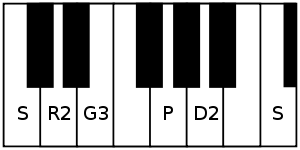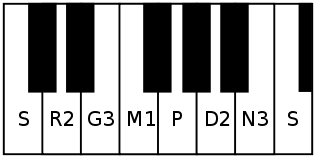Bilahari
Bilahari is a rāgam in Carnatic music (musical scale of South Indian classical music). It is basically a raga of Bengal. It is a janya rāgam (derived scale) from the 29th melakarta scale Sankarabharanam. It is a janya scale, as it does not have all the seven swaras (musical notes) in the ascending scale. It is a combination of the pentatonic scale Mohanam and the sampurna raga scale Sankarabharanam.[1] It is a morning rāgam.[1][2]
| Arohanam | S R₂ G₃ P D₂ Ṡ |
|---|---|
| Avarohanam | Ṡ N₃ D₂ P M₁ G₃ R₂ S |
| Carnatic music |
|---|
Tanjavur-style Tambura |
| Concepts |
| Compositions |
| Instruments |
|
Structure and Lakshana


Bilahari is an asymmetric rāgam that does not contain madhyamam or nishādham in the ascending scale. It is an audava-sampurna rāgam (or owdava rāgam, meaning pentatonic ascending scale).[1][2] Its ārohaṇa-avarohaṇa structure (ascending and descending scale) is as follows:
- ārohaṇa : S R₂ G₃ P D₂ Ṡ[lower-alpha 1]
- avarohaṇa : Ṡ N₃ D₂ P M₁ G₃ R₂ S[lower-alpha 2]
The notes used in this scale are shadjam, chathusruthi rishabham, antara gandhara, panchamam and chathusruthi dhaivatham in ascending scale, with kakali nishadham and shuddha madhyamam included in descending scale. For the details of the notations and terms, see swaras in Carnatic music.
This rāgam also uses kaisiki nishadham (N2) as an external note (anya swara) in the descending scale. Hence it is considered a bhashanga rāgam, a scale with notes external to the parent scale.[1][2]
Popular Compositions
There are many compositions set to Bilahari rāgam. Here are some MASSIVELY popular kritis composed in Bilahari.
- Na jeevadhara, Dorakuna ituvanti and Kanukontini composed by Tyagaraja
- Sri Balasubramanya by Muthuswami Dikshitar
- Smara Sada, Aaradhayami, Gopalam Seveham, Pahi Padmanabha, Jaya Suganalaya, Pahi Sarasanabha, Santhatham Bhajami and Vimukhava Tava by Maharaja Swathi Thirunal Rama Varma
- Parithana michite by Patnam Subramania Iyer
- Sri Chamundeshwari by Mysore Vasudevacharya
- Anaamilo mahaboob is a Khayal in Hindi by Maharaja Swathi Thirunal Rama Varma
- Puraya Mama Kamam is a Tharangam by Narayana Teertha
- "Raa ra venu gopala" a famous Swarajathi was composed in Bilahari
- Rabindranath Tagore has composed 'Ami Marer Sagor Pari Debo' In Raga Bilahari.
- " Intha Chouka" is a varnam composed by Veenai Kuppaiyer
Film songs
Language:Tamil
| Song | Movie | Composer | Singer |
|---|---|---|---|
| Unnaikkandu Naanada | Kalyana Parisu | A. M. Rajah | P. Susheela |
| Orumaiyudan Ninathu Thirumalaradi | Konjum Salangai | S. M. Subbaiah Naidu | Soolamangalam Rajalakshmi |
| Kondaliley Megam | Bala Nagamma | Illayaraja | K.J. Yesudas |
| Nee ondruthan | Unnal Mudiyum Thambi | ||
| Maaman Veedu | Ellam Inba Mayyam | Malaysia Vasudevan | |
| Netru illatha matram | Pudhiya Mugam | A. R. Rahman | Sujatha Mohan |
| Omanne penne | Vinnaithaandi Varuvaayaa | Benny Dayal, Kalyani Menon | |
| Poo pokum oosai | Minsara Kanavu | Sujatha Mohan | |
| Pookale Satru | I | Haricharan, Shreya Ghoshal | |
| Kadhal Anukkal | Enthiran | Vijay Prakash, Shreya Ghoshal | |
| Vaanga Makka Vaanga | Kaaviya Thalaivan | Haricharan,Dr. Narayanan | |
| Vaan Engum Nee Minna | Endrendrum Punnagai | Harris Jeyaraj | Aalap Raju, Harini, Devan, Praveen |
| Then Kathu | Gethu | Haricharan, Shashaa Tirupati | |
| Kanna Nee Thoongadaa | Baahubali 2: The Conclusion | M. M. Keeravani | Nayana Nair |
Related rāgams
This section covers the theoretical and scientific aspect of this rāgam.
Scale similarities
- Mohanam has a symmetric pentatonic scale, with the notes same as the ascending scale of Bilahari. Its ārohaṇa-avarohaṇa structure is S R2 G3 P D2 S : S D2 P G3 R2 S
- Mohanakalyani is a rāgam which has the prati madhyamam in descending scale (descending scale of Kalyani) in place of the shuddha madhyamam. Its ārohaṇa-avarohaṇa structure is S R2 G3 P D2 S : S N3 D2 P M2 G3 R2 S
- Garudadhvani is a rāgam which has the ascending and descending scales interchanged, in comparison with Bilahari. Its ārohaṇa-avarohaṇa structure is S R2 G3 M1 P D2 N3 S : S D2 P G3 R2 S
Desakshi is a raga which is similar to Bilahari. The arohana remains the same, while the sampoorna avarohana has Kaishiki Nishada in place of Kakali Nishada.
Notes
- Alternate notations:
- Hindustani: S R G P D Ṡ
- Western: C D E G A C
- Alternate notations:
- Hindustani: Ṡ N D P M G R S
- Western: C B A G F E D C
References
- Ragas in Carnatic music by Dr. S. Bhagyalekshmy, Pub. 1990, CBH Publications
- Raganidhi by P. Subba Rao, Pub. 1964, The Music Academy of Madras